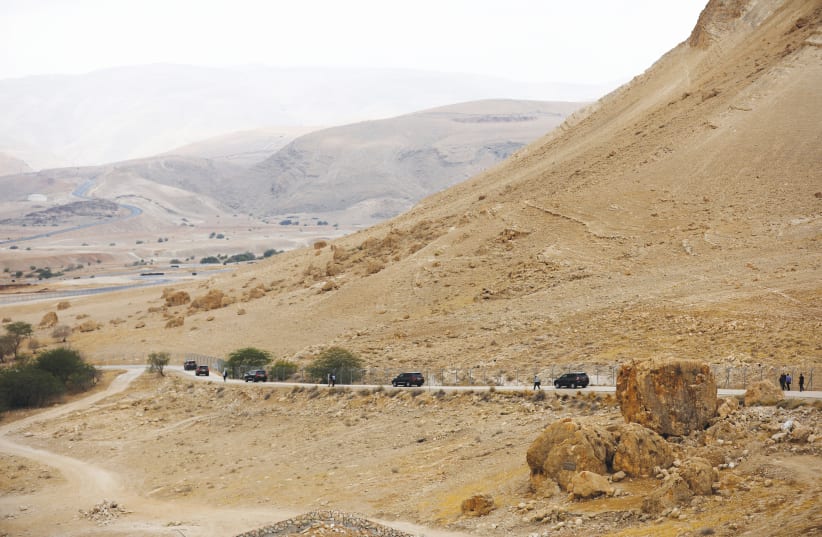A bill that would apply sovereignty to the Jordan Valley is currently being pushed in the Knesset. Members of Knesset should support the initiative, as annexing the Jordan Valley will help bolster Israel’s security for the foreseeable future.The Jordan Valley serves as Israel’s frontline of defense during conventional wars from any opposing attacks coming from the East. Israel has a width of about 9.3 miles at its narrowest from the Mediterranean to the Green Line, which would be nearly impossible to defend in the event of an invasion. However, Israel’s width from the Mediterranean to the Jordan River is on average around 40 miles, which provides Israel with the necessary strategic depth to withstand an attack.Likewise, the inimitable geographical features of the Jordan Valley provide Israel with defensible borders. The Jordan Valley rises from an area that lies 1,300 feet below sea level to the eastern slopes of the West Bank mountain ridge, which at its highest point stands around 3,600 feet above sea level. The Jordan Valley thus creates a 4,000-foot topographical barrier that makes it difficult for an opposing army attacking from the East to traverse, especially with large artillery such as tanks. The Jordan Valley contains only five mountain passages, which makes it easy for Israel to defend.
Of equal importance is the IDF’s ability to thwart terrorist infiltrations and smuggling via the Jordan Valley. The Gaza-Jericho Agreement signed in 1994 by Israel and the PLO created a narrow strip along the border area between Egypt and Gaza that would be controlled by the IDF. The agreement designated this area as the “military installation area” but was referred to by the IDF as the “Philadelphi Route.” Palestinian organizations began to create smuggling tunnels underneath the Philadelphi Route, however, the IDF was able to identify the location of the tunnels along this strip of land and eliminate them.Once Israel withdrew from Gaza, though, Israel was no longer able to send in forces to try to destroy these tunnels, so their number proliferated. Without the IDF patrolling the border area, Hamas and other terrorists were able to capitalize on this by significantly increasing the number of weapons they were able to import via the tunnels running underneath the Philadelphi Route.After the first year following Israel’s withdrawal from Gaza, rocket attacks against Israel increased by more than 500%. Over time, the weapons that terrorists were able to acquire became increasingly long-range and lethal. Hamas was able to acquire SA-7 anti-aircraft missiles that came from Libya through the smuggling tunnels. Iran was also a large supplier of the weapons that Hamas was receiving, upgrading their arsenal with 120mm Grad rockets and Fajr-5 missiles.IRAN WAS able to do this by flying in missiles and other weapons into Sudan, which would then be taken across Egypt and into the Sinai Peninsula. From there, the weapons would be smuggled through the tunnels running underneath the Philadelphi Route, where they would end up in the hands of Hamas and other terrorist organizations like Palestinian Islamic Jihad. Hamas operatives have also been able to freely travel through the tunnels into Egypt, where they board flights to Damascus and then to Iran in order to receive training from the Iranian Revolutionary Guards.The Jordan Valley serves a comparable function to the Philadelphi Route in Gaza. Israeli control in the Jordan Valley enables it to prevent terrorist infiltrations and the importation of weapons into Judea and Samaria. This already could be seen when in July 2016, the IDF was able to thwart an attempt to smuggle weapons from Jordan into the Jordan Valley. Additionally, in July 2014, the IDF was able to foil an attempt to smuggle weapons and drugs from Jordan into Israel on a boat that sailed across the northern portion of the Dead Sea.The rise of terrorist organizations near Israel’s borders, coupled with the increasing Iranian entrenchment in Iraq and Syria, makes retaining the Jordan Valley even more critical. If Israel does not control the Jordan Valley, Iran could try to replicate what it has been able to do in Gaza, by having weapons smuggled from Iraq or Syria to Jordan and then through the Jordan Valley into Judea and Samaria. Different terrorist organizations from across the region could also try to do the same.Missiles fired from Judea and Samaria pose a much graver threat in comparison to those fired from Gaza. Israel’s coastal plain contains 70% of its population and 80% of its industry. This means if rockets were to be fired from Judea and Samaria into the center of Israel, they would come crashing into major population centers, which could end up paralyzing the country.Some have argued that international forces should be placed along the Jordan Valley instead of Israel having sovereignty over the area. However, history has shown that international forces have been disastrous in providing security. For instance, after Israel’s disengagement from Gaza, European observers were stationed at the Rafah Crossing in Gaza to prevent weapons smuggling; however, they withdrew from their posts in 2006 after being threatened.In Lebanon, UNIFIL, which was established after Operation Litani in 1978, failed to stop the terrorist attacks against Israel and actually stifled Israel’s operations. When UNIFIL was upgraded in 2006, it failed to stop the arming of Hezbollah. Most recently, in Syria, UNDOF, which is stationed in between Israel and Syria to maintain the 1974 ceasefire, fled their positions in 2013 during the Syrian civil war. Israel should not turn over its security to international forces which have repeatedly demonstrated to be ineffective in providing security.For the reasons provided, only Israeli sovereignty over the Jordan Valley will ensure Israel’s security.The writer is a lawyer at Rudolph Clarke and a graduate of the Widener University School of Law.The security significance of annexing the Jordan Valley
Likewise, the inimitable geographical features of the Jordan Valley provide Israel with defensible borders.
